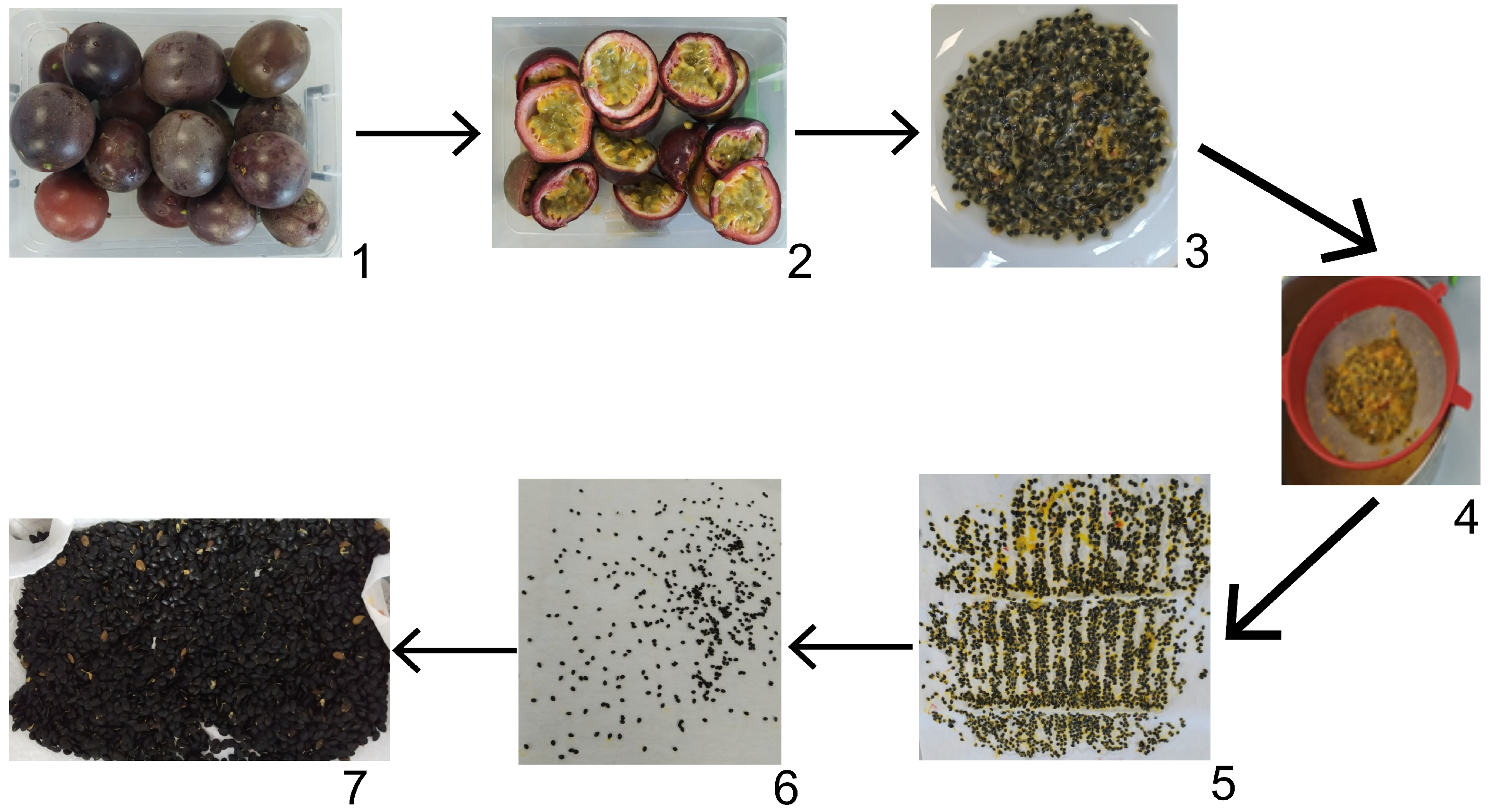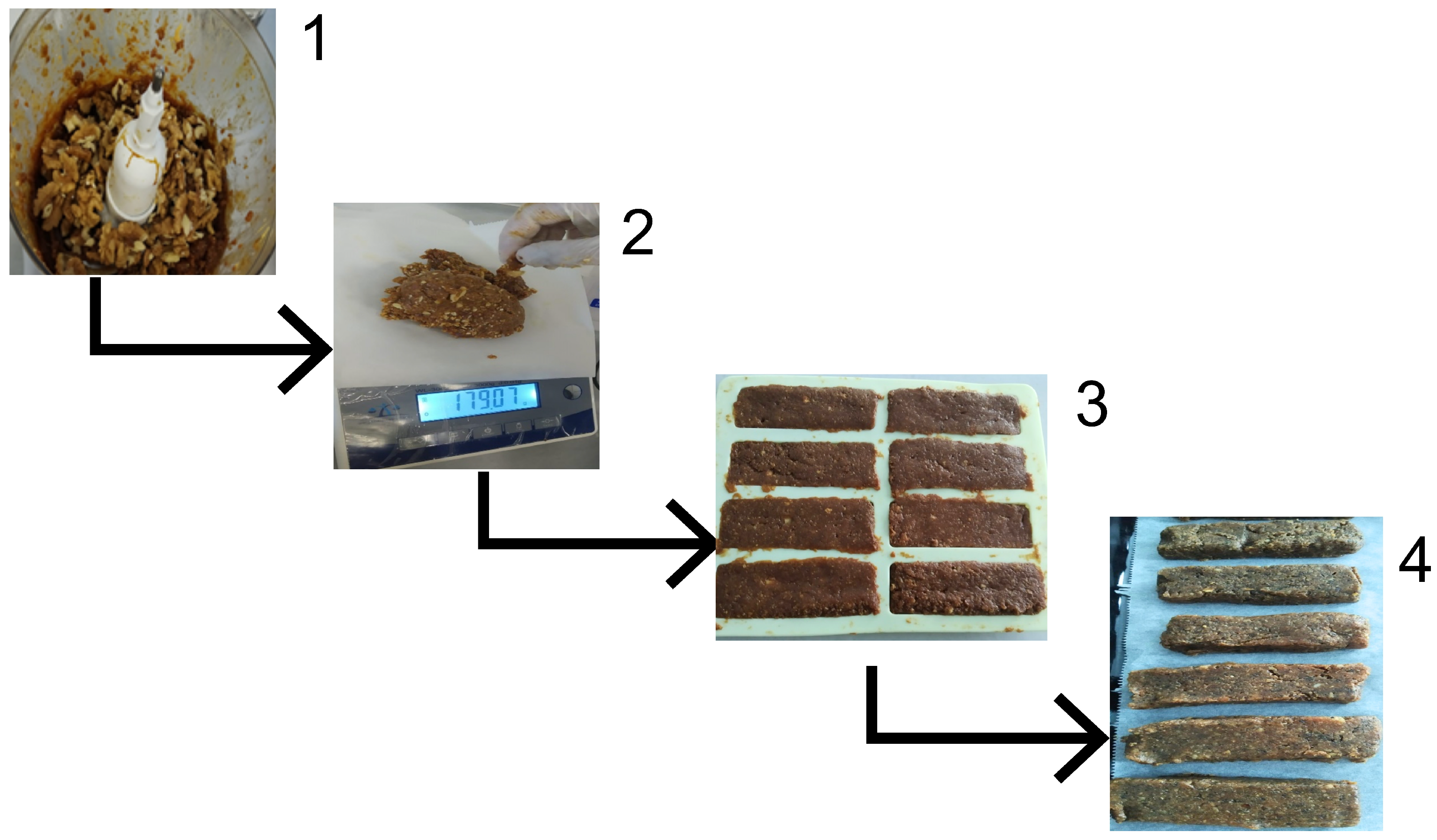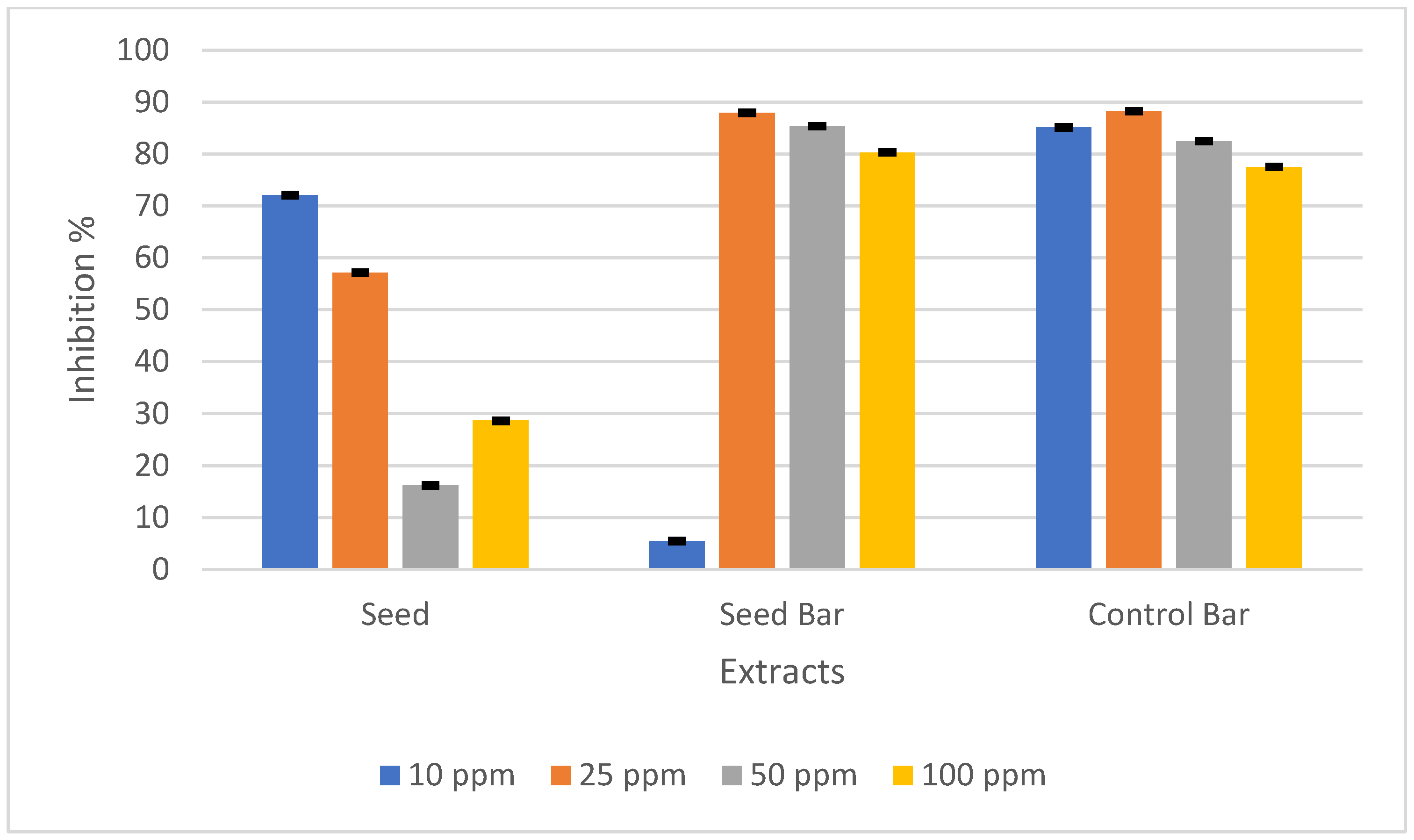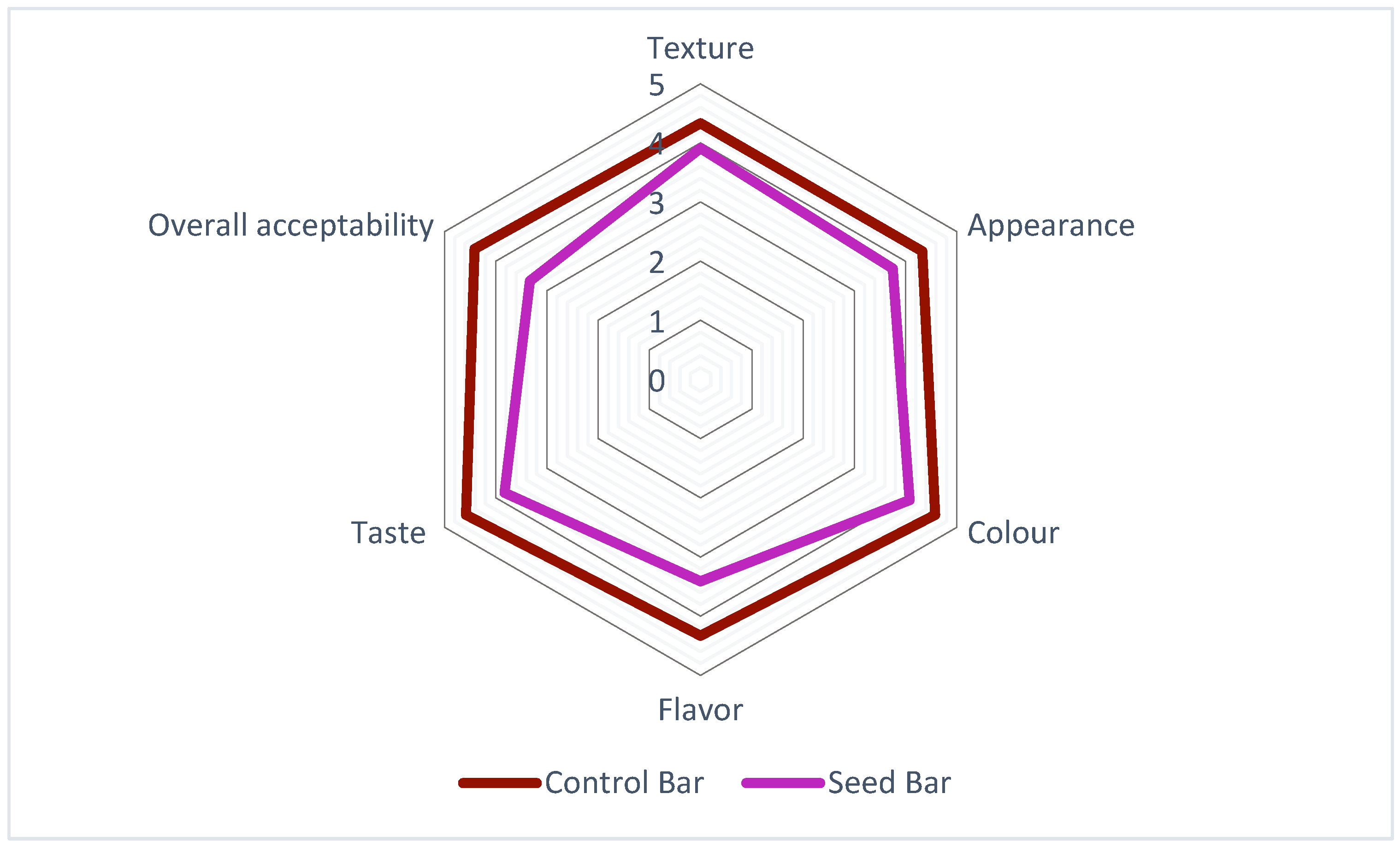Passion Fruit Seeds as a Functional Ingredient in Snack Bars: A Nutritional and Sustainable Approach
Abstract
1. Introduction
2. Materials and Methods
2.1. Materials
2.2. Preparation of P. edulis Seeds
2.3. Preparation of Snack Bars
2.4. Preparation of the Extracts
2.5. Chemical Analysis
2.6. Determination of Dry Matter
2.7. Determination of the Total Phenolic Content
2.8. Determination of the Antioxidant Activity
2.9. Microbiological Analysis
2.10. Sensory Evaluation
2.11. Statistical Analysis
3. Results
3.1. Chemical Composition
3.2. Functional Properties
3.3. Microbiological Analysis
3.4. Sensory Evaluation
4. Conclusions
Author Contributions
Funding
Institutional Review Board Statement
Informed Consent Statement
Data Availability Statement
Conflicts of Interest
Abbreviations
| AOAC | Association of Official Analytical Chemists |
| CB | Control bar |
| CFU | Colony-forming unit |
| DPPH | 2,2-Diphenyl-1-picrylhydrazyl |
| GAE | Gallic acid equivalent |
| PDA | Potato dextrose agar |
| SD | Standard deviation |
| TVC | Total viable count |
References
- Jusuf, N.K.; Putra, I.B.; Dewi, N.K. Antibacterial activity of passion fruit purple variant (Passiflora edulis sims var. edulis) seeds extract against propionibacterium acnes. Clin. Cosmet. Investig. Dermatol. 2020, 13, 99–104. [Google Scholar] [CrossRef]
- Weyya, G.; Belay, A.; Tadesse, E. Passion fruit (Passiflora edulis Sims) by-products as a source of bioactive compounds for non-communicable disease prevention: Extraction methods and mechanisms of action: A systematic review. Front. Nutr. 2024, 11, 1340511. [Google Scholar] [CrossRef]
- Chau, C.F.; Huang, Y.L. Characterization of passion fruit seed fibres—A potential fibre source. Food Chem. 2004, 85, 189–194. [Google Scholar] [CrossRef]
- Zhang, J.; Tao, S.; Hou, G.; Zhao, F.; Meng, Q.; Tan, S. Phytochemistry, nutritional composition, health benefits and future prospects of Passiflora: A review. Food Chem. 2023, 428, 136825. [Google Scholar] [CrossRef]
- Gioppato, H.A.; da Silva, M.B.; Carrara, S.; Palermo, B.R.Z.; de Souza Moraes, T.; Dornelas, M.C. Genomic and transcriptomic approaches to understand Passiflora physiology and to contribute to passionfruit breeding. Theor. Exp. Plant Physiol. 2019, 31, 173–181. [Google Scholar] [CrossRef]
- He, X.; Luan, F.; Yang, Y.; Wang, Z.; Zhao, Z.; Fang, J.; Wang, M.; Zuo, M.; Li, Y. Passiflora edulis: An insight into current researches on phytochemistry and pharmacology. Front. Pharmacol. 2020, 11, 617. [Google Scholar] [CrossRef]
- Kawakami, S.; Morinaga, M.; Tsukamoto-Sen, S.; Mori, S.; Matsui, Y.; Kawama, T. Constituent characteristics and functional properties of passion fruit seed extract. Life 2021, 12, 38. [Google Scholar] [CrossRef]
- Zhang, Y.J.; Zhou, T.; Wang, F.; Zhou, Y.; Li, Y.; Zhang, J.J.; Zheng, J.; Xu, D.P.; Li, H.B. The effects of Syzygium samarangense, Passiflora edulis and Solanum muricatum on alcohol-induced liver injury. Int. J. Mol. Sci. 2016, 17, 1616. [Google Scholar] [CrossRef]
- Guan, Y.; Sun, H.; Chen, H.; Li, P.; Shan, Y.; Li, X. Physicochemical characterization and the hypoglycemia effects of polysaccharide isolated from Passiflora edulis Sims peel. Food Funct. 2021, 12, 4221–4230. [Google Scholar] [CrossRef]
- Vuolo, M.M.; Lima, G.C.; Batista, Â.G.; Carazin, C.B.B.; Cintra, D.E.; Prado, M.A.; Júnior, M.R.M. Passion fruit peel intake decreases inflammatory response and reverts lipid peroxidation and adiposity in diet-induced obese rats. Nutr. Res. 2020, 76, 106–117. [Google Scholar] [CrossRef]
- Panelli, M.F.; Pierine, D.T.; de Souza, S.L.B.; Ferron, A.J.T.; Garcia, J.L.; Santos, K.C.D.; Belin, M.A.F.; Lima, G.P.P.; Borguini, M.G.; Minatel, I.O.; et al. Bark of Passiflora edulis treatment stimulates antioxidant capacity, and reduces dyslipidemia and body fat in db/db mice. Antioxidants 2018, 7, 120. [Google Scholar] [CrossRef]
- De Toledo, N.M.V.; De Camargo, A.C.; Ramos, P.B.M.; Button, D.C.; Granato, D.; Canniatti-Brazaca, S.G. Potentials and pitfalls on the use of passion fruit by-products in drinkable yogurt: Physicochemical, technological, microbiological, and sensory aspects. Beverages 2018, 4, 47. [Google Scholar] [CrossRef]
- Ramaiya, S.D.; Bujang, J.S.; Zakaria, M.H. Nutritive values of passion fruit (Passiflora species) seeds and its role in human health. J. Agric. Food Dev. 2018, 4, 23–30. [Google Scholar] [CrossRef]
- Krambeck, K.; Oliveira, A.; Santos, D.; Pintado, M.M.; Baptista Silva, J.; Sousa Lobo, J.M.; Amaral, M.H. Identification and quantification of stilbenes (piceatannol and resveratrol) in Passiflora edulis by-products. Pharmaceuticals 2020, 13, 73. [Google Scholar] [CrossRef]
- Fonseca, A.M.; Geraldi, M.V.; Junior, M.R.M.; Silvestre, A.J.; Rocha, S.M. Purple passion fruit (Passiflora edulis f. edulis): A comprehensive review on the nutritional value, phytochemical profile and associated health effects. Food Res. Int. 2022, 160, 111665. [Google Scholar] [CrossRef]
- da Silva, E.P.; Siqueira, H.H.; do Lago, R.C.; Rosell, C.M.; Vilas Boas, E.V.D.B. Developing fruit-based nutritious snack bars. J. Sci. Food Agric. 2014, 94, 52–56. [Google Scholar] [CrossRef]
- Tokpunar, M.; Çelik, K.E.K.; Bas, M.; Kuleaşan, H.; Altıntaş, A.K. Production of snack bar enriched with paraprobiotics grown in banana peel medium, nutritional, sensory and quality parameters. Nutr. Hosp. Órgano Of. Soc. Española Nutr. Clín. Metab. (SENPE) 2023, 40, 1166–1175. [Google Scholar] [CrossRef]
- Maleki, G.; Shadordizadeh, T.; Mozafari, M.R.; Attar, F.R.; Hesarinejad, M.A. Physicochemical and nutritional characteristics of nutrition bar fortified with cowpea protein. J. Food Meas. Charact. 2023, 17, 2010–2015. [Google Scholar] [CrossRef]
- Angulo-López, J.E.; Flores-Gallegos, A.C.; Ascacio-Valdes, J.A.; Contreras Esquivel, J.C.; Torres-León, C.; Rúelas-Chácon, X.; Aguilar, C.N. Antioxidant dietary fiber sourced from agroindustrial byproducts and its applications. Foods 2022, 12, 159. [Google Scholar] [CrossRef] [PubMed]
- Yepes, A.; Ochoa-Bautista, D.; Murillo-Arango, W.; Quintero-Saumeth, J.; Bravo, K.; Osorio, E. Purple passion fruit seeds (Passiflora edulis f. edulis Sims) as a promising source of skin anti-aging agents: Enzymatic, antioxidant and multi-level computational studies. Arab. J. Chem. 2021, 14, 102905. [Google Scholar] [CrossRef]
- Sano, S.; Sugiyama, K.; Ito, T.; Katano, Y.; Ishihata, A. Identification of the strong vasorelaxing substance scirpusin B, a dimer of piceatannol, from passion fruit (Passiflora edulis) seeds. J. Agric. Food Chem. 2011, 59, 6209–6213. [Google Scholar] [CrossRef]
- Uchida-Maruki, H.; Inagaki, H.; Ito, R.; Kurita, I.; Sai, M.; Ito, T. Piceatannol lowers the blood glucose level in diabetic mice. Biol. Pharm. Bull. 2015, 38, 629–633. [Google Scholar] [CrossRef] [PubMed]
- Gündüz, N.; Irkin, R.; Çarıkçı, S. The effect of lemon juice addition and cold storage on the total phenolic content and antioxidant activity of cold mate tea. Food Biosci. 2024, 60, 104515. [Google Scholar] [CrossRef]
- Chemists, A.O.A.; Cunniff, P. Official Methods of Analysis of the Association of Official Analytical Chemists, 15th ed.; AOAC: Washington, DC, USA, 1990. [Google Scholar]
- Singleton, V.; Rossi, J. Colorimetry of Total Phenolic Compounds with Phosphomolybdic-Phosphotungstic Acid Reagents. Am. J. Enol. Vitic. 1965, 16, 144–158. [Google Scholar] [CrossRef]
- Özer, Z.; Gören, A.C.; Kılıç, T.; Öncü, M.; Çarıkçı, S.; Dirmenci, T. The phenolic contents, antioxidant and anticholinesterase activity of section Amaracus (Gled.) Vogel and Anatolicon Ietsw. of Origanum L. species. Arab. J. Chem. 2020, 13, 5027–5039. [Google Scholar] [CrossRef]
- Irkin, R.; Arslan, M. Effect of onion (Allium cepa L.) extract on microbiological quality of refrigerated beef meat. J. Muscle Foods 2010, 21, 308–316. [Google Scholar] [CrossRef]
- Irkin, R.; Esmer, O.K. Control of Listeria monocytogenes in ground chicken breast meat under aerobic, vacuum and modified atmosphere packaging conditions with or without the presence of bay essential oil at 4 C. Food Sci. Technol. Res. 2010, 16, 285–290. [Google Scholar] [CrossRef]
- Barakat, H.; Alfheeaid, H.A. Date palm fruit (Phoenix dactylifera) and its promising potential in developing functional energy bars: Review of chemical, nutritional, functional, and sensory attributes. Nutrients 2023, 15, 2134. [Google Scholar] [CrossRef]
- AlJaloudi, R.; Al-Dabbas, M.M.; Hamad, H.J.; Amara, R.A.; Al-Bashabsheh, Z.; Abughoush, M.; Choudhury, I.H.; Al-Nawasrah, B.A.; Iqbal, S. Development and characterization of high-energy protein bars with enhanced antioxidant, chemical, nutritional, physical, and sensory properties. Foods 2024, 13, 259. [Google Scholar] [CrossRef]
- Eid, W.A.; Azab, D.E.S.H.; Negm, S.H. Characterization of a novel date energy bar fortified with Moringa oleifera leaves powder. J. Future Foods 2025, 5, 266–275. [Google Scholar] [CrossRef]
- Ibrahim, S.A.; Fidan, H.; Aljaloud, S.O.; Stankov, S.; Ivanov, G. Application of date (Phoenix dactylifera L.) fruit in the composition of a novel snack bar. Foods 2021, 10, 918. [Google Scholar] [CrossRef] [PubMed]
- Nadeem, M.; Rehman, S.U.; Mahmood Qureshi, T.; Nadeem Riaz, M.; Mehmood, A.; Wang, C. Development, characterization, and flavor profile of nutrient dense date bars. J. Food Process. Preserv. 2018, 42, e13622. [Google Scholar] [CrossRef]
- Parn, O.J.; Bhat, R.; Yeoh, T.K.; Al-Hassan, A.A. Development of novel fruit bars by utilizing date paste. Food Biosci. 2015, 9, 20–27. [Google Scholar] [CrossRef]
- Tang, Z.X.; Shi, L.E.; Aleid, S.M. Date fruit: Chemical composition, nutritional and medicinal values, products. J. Sci. Food Agric. 2013, 93, 2351–2361. [Google Scholar] [CrossRef]
- Zheng, L.; Wang, S.; Yang, Y.; Zheng, X.; Xiao, D.; Ai, B.; Sheng, Z. Volatile aroma compounds of passion fruit seed oils: HS-GC-IMS analysis and interpretation. Food Chem. X 2024, 21, 101212. [Google Scholar] [CrossRef]
- Stanley, J.; John, A.; Pušnik Črešnar, K.; Fras Zemljič, L.; Lambropoulou, D.A.; Bikiaris, D.N. Active agents incorporated in polymeric substrates to enhance antibacterial and antioxidant properties in food packaging applications. Macromol 2022, 3, 1–27. [Google Scholar] [CrossRef]
- Vasile, C.; Baican, M. Progresses in food packaging, food quality, and safety—Controlled-release antioxidant and/or antimicrobial packaging. Molecules 2021, 26, 1263. [Google Scholar] [CrossRef] [PubMed]
- Pérez-Beltrán, Y.E.; Wall-Medrano, A.; Valencia Estrada, M.A.; Sánchez-Burgos, J.A.; Blancas-Benítez, F.J.; Tovar, J.; Sáyago-Ayerdi, S.G. In Vivo Glycemic Response of Fruit-Based Mango (Mangifera indica) and Pineapple (Ananas comosus) Bars in In Vitro and In Silico Enzyme Inhibitory Effects Studies. Foods 2024, 13, 2258. [Google Scholar] [CrossRef] [PubMed]
- Zulaikha, Y.; Yao, S.H.; Chang, Y.W. Physicochemical and functional properties of snack bars enriched with tilapia (Oreochromis niloticus) by-product powders. Foods 2021, 10, 1908. [Google Scholar] [CrossRef]
- Munir, M.; Nadeem, M.; Qureshi, T.M.; Qayyum, A.; Suhaib, M.; Zeb, F.; Ashokkumar, M. Addition of oat enhanced the physico-chemical, nutritional and sensory qualities of date fruit based snack bars. J. Food Nutr. Res. 2018, 6, 271–276. [Google Scholar]
- Alfheeaid, H.A.; Barakat, H.; Althwab, S.A.; Musa, K.H.; Malkova, D. Nutritional and physicochemical characteristics of innovative high energy and protein fruit-and date-based bars. Foods 2023, 12, 2777. [Google Scholar] [CrossRef]
- Silva, R.M.; Placido, G.R.; Silva, M.D.; Castro, C.D.S.; Lima, M.S.; Caliari, M. Chemical characterization of passion fruit (Passiflora edulis f. flavicarpa) seeds. Afr. J. Biotechnol. 2015, 14, 1230–1233. [Google Scholar] [CrossRef]
- Delvar, A.; de Caro, P.; Candy, L.; Caro, Y.; Sing, A.S.C.; Raynaud, C. Integrated process for extraction and formulation in emulsions of active molecules from fresh passion fruits (Passiflora edulis Sims). J. Food Eng. 2019, 263, 388–397. [Google Scholar] [CrossRef]
- Sun-Waterhouse, D.; Teoh, A.; Massarotto, C.; Wibisono, R.; Wadhwa, S. Comparative analysis of fruit-based functional snack bars. Food Chem. 2010, 119, 1369–1379. [Google Scholar] [CrossRef]
- de Oliveira, A.C.; Valentim, I.B.; Silva, C.A.; Bechara, E.J.H.; de Barros, M.P.; Mano, C.M.; Goulart, M.O.F. Total phenolic content and free radical scavenging activities of methanolic extract powders of tropical fruit residues. Food Chem. 2009, 115, 469–475. [Google Scholar] [CrossRef]
- Martínez, R.; Torres, P.; Meneses, M.A.; Figueroa, J.G.; Pérez-Álvarez, J.A.; Viuda-Martos, M. Chemical, technological and in vitro antioxidant properties of mango, guava, pineapple and passion fruit dietary fibre concentrate. Food Chem. 2012, 135, 1520–1526. [Google Scholar] [CrossRef]
- Dos Reis, L.C.R.; Facco, E.M.P.; Salvador, M.; Flôres, S.H.; de Oliveira Rios, A. Antioxidant potential and physicochemical characterization of yellow, purple and orange passion fruit. J. Food Sci. Technol. 2018, 55, 2679–2691. [Google Scholar] [CrossRef]
- de Santana, F.C.; de Oliveira Torres, L.R.; Shinagawa, F.B.; de Oliveira ESilva, A.M.; Yoshime, L.T.; de Melo, I.L.P.; Marcellini, P.S.; Mancini-Filho, J. Optimization of the antioxidant polyphenolic compounds extraction of yellow passion fruit seeds (Passiflora edulis Sims) by response surface methodology. J. Food Sci. Technol. 2017, 54, 3552–3561. [Google Scholar] [CrossRef]
- Matsui, Y.; Sugiyama, K.; Kamei, M.; Takahashi, T.; Suzuki, T.; Katagata, Y.; Ito, T. Extract of passion fruit (Passiflora edulis) seed containing high amounts of piceatannol inhibits melanogenesis and promotes collagen synthesis. J. Agric. Food Chem. 2010, 58, 11112–11118. [Google Scholar] [CrossRef]
- Kitada, M.; Ogura, Y.; Maruki-Uchida, H.; Sai, M.; Suzuki, T.; Kanasaki, K.; Hara, Y.; Seto, H.; Kuroshima, Y.; Monno, I.; et al. The effect of piceatannol from passion fruit (Passiflora edulis) seeds on metabolic health in humans. Nutrients 2017, 9, 1142. [Google Scholar] [CrossRef]
- Morais, D.R.; Rotta, E.M.; Sargi, S.C.; Schmidt, E.M.; Bonafe, E.G.; Eberlin, M.N.; Sawaya, A.C.H.F.; Visentainer, J.V. Antioxidant activity, phenolics and UPLC–ESI (–)–MS of extracts from different tropical fruits parts and processed peels. Food Res. Int. 2015, 77, 392–399. [Google Scholar] [CrossRef]
- Bratosin, B.C.; Martău, G.-A.; Ciont, C.; Ranga, F.; Simon, E.; Szabo, K.; Darjan, S.; Teleky, B.-E.; Vodnar, D.C. Nutritional and physico-chemical characteristics of innovative bars enriched with Aronia melanocarpa by-product powder. Appl. Sci. 2024, 14, 2338. [Google Scholar] [CrossRef]
- Tournas, V.H.; Katsoudas, E. Mould and yeast flora in fresh berries, grapes and citrus fruits. Int. J. Food Microbiol. 2005, 105, 11–17. [Google Scholar] [CrossRef]
- Munshi, R.; Kochhar, A.; Kaur, A. Nutrient selection and optimization to formulate a nutrient bar stable on storage and specific to women at risk of osteoporosis. J. Food Sci. Technol. 2020, 57, 3099–3107. [Google Scholar] [CrossRef] [PubMed]
- Mridula, D.; Singh, K.K.; Barnwal, P. Development of omega-3 rich energy bar with flaxseed. J. Food Sci. Technol. 2013, 50, 950–957. [Google Scholar] [CrossRef]
- Sabeel, V.A.; Wani, K.M.; Dubey, P.K.; Reddy, M.V.K.; Kumar, S. Pseudocereals and dates as potential ingredients in nutrition bars: A review. Nutrire 2024, 49, 38. [Google Scholar] [CrossRef]




| Nutritional Composition | Control Bars Mean ± SD | Seed Bars Mean ± SD |
|---|---|---|
| Energy (kcal/100 g) | 379.8 ± 2.20 a | 393.3 ± 2.13 b |
| Carbohydrate (% m/m) | 49.92 ± 2.51 a | 42.35 ± 2.13 b |
| Fat (% m/m) | 15.02 ± 1.06 a | 19.63 ± 1.39 b |
| Protein (Nx6.25) (% m/m) | 11.24 ± 0.75 a | 11.83 ± 0.79 a |
| Ash (% m/m) | 1.82 ± 0.15 a | 1.80 ± 0.15 a |
| Cellulose (% m/m) | 5.13 ± 0.23 a | 7.84 ± 0.35 b |
| Moisture (% m/m) | 16.87 ± 1.49 a | 16.56 ± 1.46 a |
| Dietary Fiber (% m/m) | 4.17 ± 0.50 a | 5.66 ± 0.68 b |
| pH | 5.59 ± 0.01 a | 5.62 ± 0.01 b |
| Control Bars Mean ± SD | Seed Bars Mean ± SD | |
|---|---|---|
| Calcium (mg/kg) | 948.92 ± 319.75 a | 962.17 ± 324.22 a |
| Magnesium (mg/kg) | 619.76 ± 194.05 a | 704.18 ± 220.49 a |
| Zinc (mg/kg) | 15.14 ± 4.18 a | 15.21 ± 4.20 a |
| Sodium (mg/kg) | 1410.78 ± 517.02 a | 1116.48 ± 409.16 a |
| Potassium (mg/kg) | 11,327.47 ± 3568.75 a | 13,016.36 ± 4100.84 a |
| Iron (mg/kg) | 21.63 ± 3.43 a | 17.95 ± 2.85 a |
| Total Phenolic Content Mean ± SD | |
|---|---|
| Seed (mg GAE/100 g) | 140.02 ± 0.85 |
| Seed Bars (mg GAE/100 g) | 65.37 ± 0.26 |
| Control Bars (mg GAE/100 g) | 90.11 ± 0.32 |
| Control Bar | Seed Bar | |||||
|---|---|---|---|---|---|---|
| Measure | Day 1 | Day 3 | Day 7 | Day 1 | Day 3 | Day 7 |
| Yeast (log CFU/g) | 2.66 | 3.00 | 4.36 | 3.28 | 4.30 | 4.58 |
| Mold (log CFU/g) | - | - | - | - | - | - |
| Total viable count (TVC) (log CFU/g) | 3.49 | 4.37 | 4.11 | 3.62 | 4.14 | 4.43 |
Disclaimer/Publisher’s Note: The statements, opinions and data contained in all publications are solely those of the individual author(s) and contributor(s) and not of MDPI and/or the editor(s). MDPI and/or the editor(s) disclaim responsibility for any injury to people or property resulting from any ideas, methods, instructions or products referred to in the content. |
© 2025 by the authors. Licensee MDPI, Basel, Switzerland. This article is an open access article distributed under the terms and conditions of the Creative Commons Attribution (CC BY) license (https://creativecommons.org/licenses/by/4.0/).
Share and Cite
Karaca Çelik, K.E.; Irkin, R.; Çarıkçı, S.; Sipahi, S.; Yakar, S.; Yaman, C.; Öneş, E. Passion Fruit Seeds as a Functional Ingredient in Snack Bars: A Nutritional and Sustainable Approach. Foods 2025, 14, 1857. https://doi.org/10.3390/foods14111857
Karaca Çelik KE, Irkin R, Çarıkçı S, Sipahi S, Yakar S, Yaman C, Öneş E. Passion Fruit Seeds as a Functional Ingredient in Snack Bars: A Nutritional and Sustainable Approach. Foods. 2025; 14(11):1857. https://doi.org/10.3390/foods14111857
Chicago/Turabian StyleKaraca Çelik, Kezban Esen, Reyhan Irkin, Sema Çarıkçı, Simge Sipahi, Selinay Yakar, Cem Yaman, and Ece Öneş. 2025. "Passion Fruit Seeds as a Functional Ingredient in Snack Bars: A Nutritional and Sustainable Approach" Foods 14, no. 11: 1857. https://doi.org/10.3390/foods14111857
APA StyleKaraca Çelik, K. E., Irkin, R., Çarıkçı, S., Sipahi, S., Yakar, S., Yaman, C., & Öneş, E. (2025). Passion Fruit Seeds as a Functional Ingredient in Snack Bars: A Nutritional and Sustainable Approach. Foods, 14(11), 1857. https://doi.org/10.3390/foods14111857







